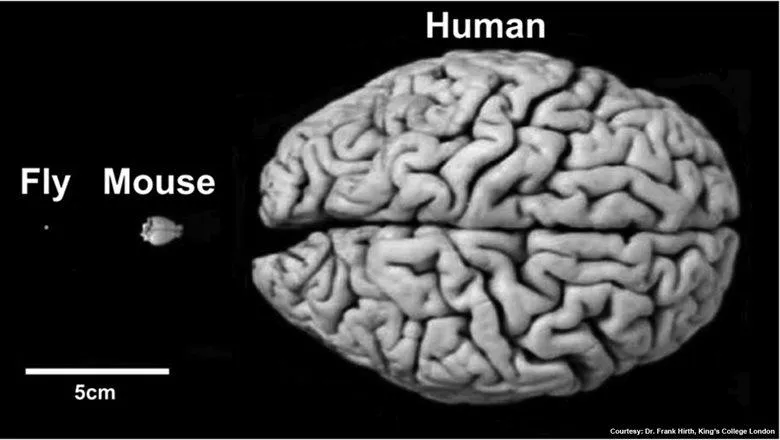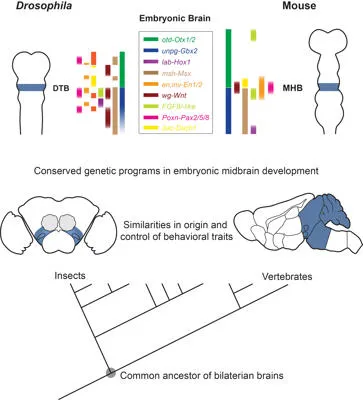To my knowledge this is the first study that provides evidence of the source of similarities between human and fly brains, how they form and how they function.
Senior author on the study, Dr Frank Hirth from the Institute of Psychiatry, Psychology & Neuroscience (IoPPN), King’s College London
03 August 2020
Humans and flies employ very similar mechanisms for brain development and function
A new study led by researchers from King’s College London has shown that humans, mice and flies share the same fundamental genetic mechanisms that regulate the formation and function of brain areas involved in attention and movement control.

With these new findings scientists can potentially better understand the subtle changes that can occur in genes and brain circuits that can lead to mental health disorders such as anxiety and autism spectrum disorders.
Although physically very different, research has found that the brains of flies, mice and humans are similar in how they form and how they function. Data has shown that the genetic mechanisms that underlie the brain development of insects and mammals are very similar but this can be interpreted in two different ways, where some believe it provides evidence of one single ancestor for both mammals and insects and others think it could support the theory that brains evolved multiple times independently.
He continued, ‘Our research shows that the brain circuits essential for coordinated behaviour are put in place by similar mechanisms in humans, flies and mice. This indicates that the evolution of their very different brains can be traced back to a common ancestral brain more than a half billion years ago.’
Published in the journal Proceedings of the National Academy of Sciences (PNAS), this collaborative study between King’s College London, University of Arizona, University of Leuven and Leibniz Institute DSMZ has provided strong evidence that the mechanisms that regulate genetic activity required for the formation of brain areas important to control behaviour, is the same for insects and mammals.
Most strikingly they have demonstrated that when these regulatory mechanisms are inhibited or impaired in insects and mammals they experience very similar behavioural problems. This indicates that the same building blocks that control the activity of genes are essential to both the formation of brain circuits and the behaviour-related functions they perform. According to the researchers this provides evidence that these mechanisms have been established in one common ancestor.
'The jigsaw puzzle of how the brain evolved still lacks an image on the box, but the pieces currently being added suggest a very early origin of essential circuits that, over an immense span of time have been maintained, albeit with modification, across the great diversity of brains we see today.
Nicholas Strausfeld, Regents Professor of Neuroscience at the University of Arizona and a co-author on the study
The study focussed on those areas of the brain known as the deutocerebral-tritocerebral boundary (DTB) in flies and the midbrain-hindbrain boundary (MHB) in vertebrates including humans. Using genomic data, researchers identified the genes that play a major role in the formation of the brain circuits that are responsible for basic motion in the DTB in flies and MHB in humans. They then ascertained the parts of the genome that control when and where these genes are expressed, otherwise known as cis-regulatory elements.

The researchers found that these cis-regulatory elements are very similar in flies, mice and humans, indicating that they share the same fundamental genetic mechanism by which these brain areas develop. By manipulating the relevant genomic regions in flies so they no longer regulate the genes appropriately, the researchers showed a subsequent impairment in behaviour. This corresponds to findings from research with people where mutations in gene regulatory sequences or the regulated genes themselves have been associated with behavioural problems including anxiety and autism spectrum disorders.
For many years researchers have been trying to find the mechanistic basis behind behaviour and I would say that we have discovered a crucial part of the jigsaw puzzle by identifying these basic genetic regulatory mechanisms required for midbrain circuit formation and function.
Dr Frank Hirth from the IoPPN, King’s College London
Dr Hirth added ‘If we can understand these very small, very basic building blocks, how they form and function, this will help find answers to what happens when things go wrong at a genetic level to cause these disorders.’
Funding for this study was provided by the Ministry of Education of Brazil, King’s College London, the Research Foundation Flanders, the US National Science Foundation, the UK Medical Research Council, the UK Biotechnology and Biological Sciences Research Council and the Motor Neurone Disease Association.
Reference: Bridi, J. et al. (2020) Ancestral regulatory mechanisms specify conserved midbrain circuitry in arthropods and vertebrates Proceedings of the National Academy of Sciences (PNAS) DOI: 10.1073/pnas.1918797117
Contact
For interviews or any further media information please contact:
Franca Davenport, Interim Senior Press Officer, IoPPN: franca.davenport@kcl.ac.uk +44 7718 697176

